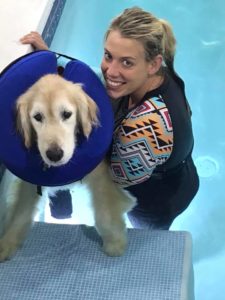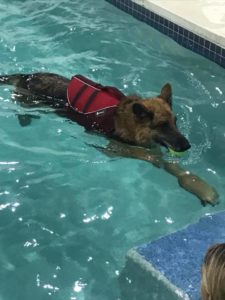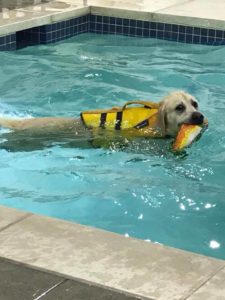This is a great article with precious advices from Laurie Duperier that she wrote for the NoVa Dog Magazine.
Laurie Plessala Duperier is an author and expert on caring for aging dogs. Living with Gunny, her soul mate, changed her life and taught her almost everything she knows about everything. Before devoting herself to dogs, she was an international lawyer. Later she ran Gunny’s Rainbow, a warm water healing facility in Bethesda, for 8 years. You can learn about The Endless Path, the book she wrote with Gunny, at theendlesspath.com. It is widely available on Amazon, Barnes & Noble, and other online retailers.
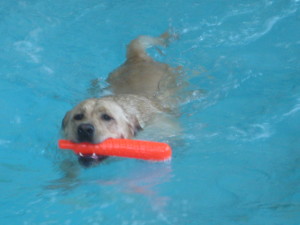 These days, our animal companions are living longer than ever. But many of those last years can prove quite challenging given the rate of cancer, heart problems, degenerative diseases, and orthopedic ailments that our older dogs face—just like the aging human population. The tests, treatment options, and supportive therapies can seem overwhelming when your dog experiences a significant health problem. The costs can be staggering. And while we all want our animal companions to stay with us as long as possible, what most of us really want is for them to be happy and have quality of life all the days that they are here.
These days, our animal companions are living longer than ever. But many of those last years can prove quite challenging given the rate of cancer, heart problems, degenerative diseases, and orthopedic ailments that our older dogs face—just like the aging human population. The tests, treatment options, and supportive therapies can seem overwhelming when your dog experiences a significant health problem. The costs can be staggering. And while we all want our animal companions to stay with us as long as possible, what most of us really want is for them to be happy and have quality of life all the days that they are here.
I spent the better part of the last 12 years tending to elderly and dying dogs, both my own and others’. For eight years I ran Gunny’s Rainbow, a warm water healing facility in Bethesda, and specialized in supporting geriatric dogs and their people. While I started out swimming with all kinds of dogs, from young ones looking for exercise to surgical rehabbers to geriatrics, over time I focused exclusively on the seniors, knowing there were other swim options for the younger pups.
Fundamentally, old dogs are my calling and my passion. I love them—they are my life coaches! In fact, I first built Gunny’s Rainbow for my elderly dog, Gunny, who you can probably guess I named the place after.
I could write a book about all that I learned from the dogs, their humans, and some very committed and knowledgeable specialists and holistic practitioners. In fact, I am going to write that book! But for now, I want to share some of what I learned about supporting an older dog with significant spinal or orthopedic issues, which is more common among large breeds than small, although they can affect any canine.
Sometimes Less is More
When your dog starts to limp or acts tired during or after playtime or retrieving, rein in the activity. This is a sign of discomfort—not just being older. Their big canine hearts sometimes want to do more than their aging bodies can handle. Consider several 15-minute walks instead of one or two 20- to 30-minute ones. After all, for most dogs, the only thing better than two walks is three!
You may also need to limit retrieving the ball for extended periods, even when the drive is there and they want to go go go. Just like people who have arthritis, moderate exercise several times a day is much better than a long marathon session that over-stresses their muscles and joints.
Last but not least, do not ask your elderly dog to be a “weekend warrior.” Asking them to go for a long 45-minute walk on a nice day when they are only accustomed to short ones can do more harm than good.
Water is Magic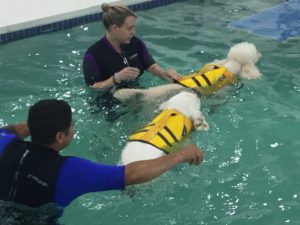
While weight-bearing exercise has its place, for an old dog with disk disease, degenerative myelopathy, or arthritis, it is weightless aerobic exercise that can really make the difference.
The benefits of water exercise are well-documented and numerous. Swimming or walking on an underwater treadmill allows your dog to work his muscles and joints without the concussive impact of paws on pavement, which can be painful. The hydrostatic pressure of the water helps with joint pain if they stay in the water long enough. If you can find a facility with water upwards of 87 degrees, your dog can get a lot of pain relief from the heat penetrating his joints. When you reduce their pain, dogs can use their muscles and joints more easily, which of course helps them walk better. Even if your dog was not a water fan earlier in life, consider giving it a try. The ability to move without pain can make almost any old dog a fan of water exercise.
As important as those physical benefits are, the mental and emotional benefits are no less impressive. I cannot count the number of retrievers I saw who literally “came back to life” at being able to retrieve a ball for their mom or dad, often for the first time in years. They are proud and happy to feel like a “big young dog” again. One of the reasons for that is biochemical: just like us, when dogs get their heartrates up, they release endorphins, dopamine, seratonin, and other feel-good chemicals that lift negative feelings and improve their mood. Think about it. Your 13-year-old dog likely doesn’t run anymore or really get her heart rate up, and that means she’s not getting good aerobic exercise. Exercising in water allows a dog to do that safely (assuming they have no underlying heart condition), so it is both a physical and psychological win.
Do Not Wait to Address Aging Issues
Many times I silently lamented that someone waited so long to bring their dog to swim. If only they had come 6 months or a year earlier, when their dog had more muscle, I could have helped more. Just like your grandmother no longer builds significant muscle, your 13-year-old dog is unlikely to bulk up again once that strength is gone. The name of the game, especially for degenerative conditions like disk disease and arthritis, is to maintain muscle mass for as long as you can. You can do that in two ways: by easing their physical pain so they can comfortably exercise, and by getting the right kind of exercise.
These days there are so many options, both holistic and traditional, to help your senior dog. Explore them all, and don’t be discouraged if a particular treatment doesn’t work, since medical care is not “one size fits all.” Try something else! Some options cost very little, like making Golden Paste (a natural anti-inflammatory made from turmeric). Some are relatively expensive, like regular acupuncture or chiropractic care. And there are exciting new things out there like CBD oil made from hemp or cannabis, which can help ease pain. Be aware of what’s out there!
Also, talk to your vet. Go see a neurologist, orthopedic surgeon, or rehabilitation therapist. Consult a holistic practitioner. But definitely don’t postpone the issue until your dog can no longer get up on his own, or falls down constantly. Generally, these issues will not get better with time—only worse. However, with patience and determination, my experience is that you can find a combination of therapies that helps your dog.
The Small Stuff Matters
Be mindful of details when it comes to your elderly dog. Here are a few points to keep in mind.
1. Keep your dog’s nails trimmed short so they can get all the way up on their paws and are not shifting their weight back to the weaker hind end.
2. Cut the hair in between the paws on their feet. When they’re walking around with hair covering their paw pads, it is like being on ice skates on a slippery hardwood floor. Paw pad traction helps their stability.
3. Invest in carpet squares, runners, or yoga mats and put them on stairs and on slick surfaces where your dog walks. It is easy to strain a groin muscle if they go splat with their hind legs out, and very tough to fully recover from that.
4. Get a harness to help them off the floor and/or a sling to support them going up and down stairs. Going down stairs is very dangerous for a dog with hind end weakness because they end up descending like a runaway train and can really injure themselves. Fall prevention is obviously preferable to recovering from a fall.
5. Be sure that your dog is eating a low to no carbohydrate diet and getting appropriate supplements like fish oil, Vitamin E, and Vitamin B if appropriate.
6. Learn some basic massage, stretching, and passive range of motion techniques to help keep your dog limber and her muscles more supple and comfortable.
Do not confuse incontinence with end of life. Many dogs with disk disease become fecal incontinent and sometimes urinary incontinent. It is a nerve conduction issue. It is not painful, nor is it a quality of life issue if you keep your dog clean, use diapers as necessary, or (even better) learn how to stimulate them to poop so they don’t have accidents when left unattended. It isn’t hard, and your vet can show you how. We think nothing of buying grandma Depends diapers at the grocery store, and we generally don’t ever talk about euthanizing her. So please learn the same caretaking skills and invest in the same types of products for your dog. He doesn’t want to poop in the house any more than you want him to. And remember that your fuzzy companion is often sensitive, so not making a fuss about an accident goes a long way to making them feel okay about what’s happening.
My beloved Gunny lived for 14 years, 9 months, and 5 days. I treasure each and every one of them, even the really hard days. Unfortunately, I learned a lot of things the hard way, so I want to make it easier for you to enjoy the time with your elderly dog. It is in that spirit I hope to share what I learned from all the dogs in my life and the people who came with them! ND


